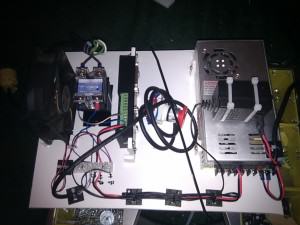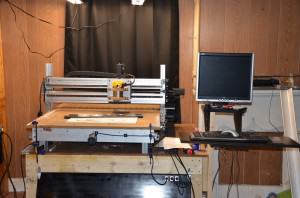Well it’s been a while since my last post and my DIY CNC router machine is ‘officially’ finished, though I don’t believe that any project like this is every truly finished as there will always be upgrades and modifications.
The last big things I had to do were to build a place to put my monitor and keyboard, and put some of the electronics together all in one location and hook them up. I used a 25 amp SSR for the spindle relay and that was super easy to connect to the Gecko G540 stepper driver. I also put a nice high speed fan and a couple of power supplies on the board as well. The board I used was an expanded PVC material called Travosil, it takes to Cyanoacrylate glues very well and the bonds are super strong and it’s easy to cut with a box knife.
I used some 4 pin XLR style connectors I got from a local audio/video supply shop (Markertek) to connect the electronics package to the outside world. On the outside world side of things I used a 4 conductor microphone cable with a shield for the leads that go through the cable chain to the steppers. The shield of the microphone cable is connected to the ground at one end only (the electronics end).
I used a heavier gauge 3-wire cord for the router control. The size doesn’t really matter as long as is can support the current draw required for the router at the distance needed. Heavier gauge generally provides lower resistance. The wire I used was a 3 conductor 10 gauge wire. I had a nice 15 amp plug I connected to one end of the cable. Partway through the cable I split off the sheath and passed the hot line (black in the US, brown in Europe) through the SSR switched side and then the cable runs out to the router via the cable chain. At the router end I simply cut the end off the power cord and spliced the extension into it.
I also built a simple stand for the monitor, keyboard and mouse. While I would have loved some fancy swinging arm setup I looked around quite a bit and they were all quite expensive. I just decided to use this method and it actually works out very well.
It wasn’t really a lot that needed to be done, I was just bogged down on working on it and needed a break for a bit. Once I got back into it it only took a couple of days to get the monitor/keyboard/mouse stand in and hook up the electronics.
The PC I’m using to run Mach 3 is pretty decent but it has a bad power supply. The machine will turn itself off randomly when it’s sitting idle, but it’s never turned off when the machine is running a job. The PC sits behind the black door in the picture above, along with the electronics package, fan and power supplies.
Overall this project has been quite a bit of work, I’ve enjoyed most of it, though I’ve had some slow times. The results were well worth the effort, there’s something awesome about being able to make custom pieces whenever you need it with just a little work in a software program.
Software has been the largest pain in the neck. Most software packages that are worth using are pretty expensive. There are some free and open source products out there, but as is common with these their user friendliness is pretty low compared to the extensive functionality that some of them provide. There’s a very steep learning curve, which can be bad because it makes using something like Autocad or Rhinocad look like a piece of cake. I’ve downloaded demos of various programs. DolphinCAD/CAM was not too bad to use and get used to and is among the more reasonable priced packages. I’ve also messed around with CamBam quite a bit and can see using this as a common CAM package for my needs. For CAD I’ve also been messing around with RhinoCAD. It seems pretty great and more similar to AutoCAD type design but it’s very expensive from a hobbyist perspective. They do offer a 30 day trial so it’s worth downloading and at least exploring it with some tutorials.
At this point I’ve just been downloading various programs and trying them out during their trial periods. I have some experience using 3D studio max for conceptual renderings and animations so the world of 3D design programs is not foreign to me. I imagine for someone who has never used them before that a 3D program would be pretty intimidating so you might want to try out a 2 or 2.5D program first. The DolphinCAD/CAM programs are 2/2.5D and CamBam is also 2D in it’s basic functions but is also capable of 2.5D and 4th Axis work. CamBam has a cool feature of built in heightmapping which lets you convert a bitmap into a 3D relief(2.5D) machine file. On the right materials you can get some awesome effects.
I’ve already moved into my first project. I built the darn machine and couldn’t think of what to make so I asked a friend for some ideas. He recommended that I make some table coasters, so that’s exactly what I did. My next post will be about how I machined the aluminum coasters and finished them.
Thanks for following my DIY CNC posts, it’s been a good project with a lot of learning involved. I’m sure I will always be making changes and modifications but as it stands is a very reasonable machine for doing wood and light aluminum work, which is what I was shooting for.
Previous: Almost Finished
Next: Chinese 2.2kW VFD Spindle Motor
Search CNC Posts



4 responses to Part 12 : DIY CNC : Finished – But is it Ever?
Sir
I just found this site and your build log for your system. My question is “Are you or have you released plans for this build?” If so I would be very interested in them as would would enjoy building it. Looking at other designs has left me with feeling that they are not as robust as yours. Please contact me with any information you are willing to share.
Thank you in advance
Jean Maue
Hello Jean, there are no plans available for this design. I just built it short and rigid so that I would be able to do light aluminum work on it. It does aluminum well for what it is. The Z axis is pretty limited in travel, it has never caused me a problem with my routing or machining projects and it can be adjusted higher if needed, but at the cost of rigidity.
Can you share your cad drawings ?
Best regards,
Hi there, I’m sorry but I don’t normally share my 3D original files. The design which I originally drew is not what I used for my final product but it was a workpiece to start from and visualize things to come up with the final design.
Leave a reply to Part 12 : DIY CNC : Finished – But is it Ever?